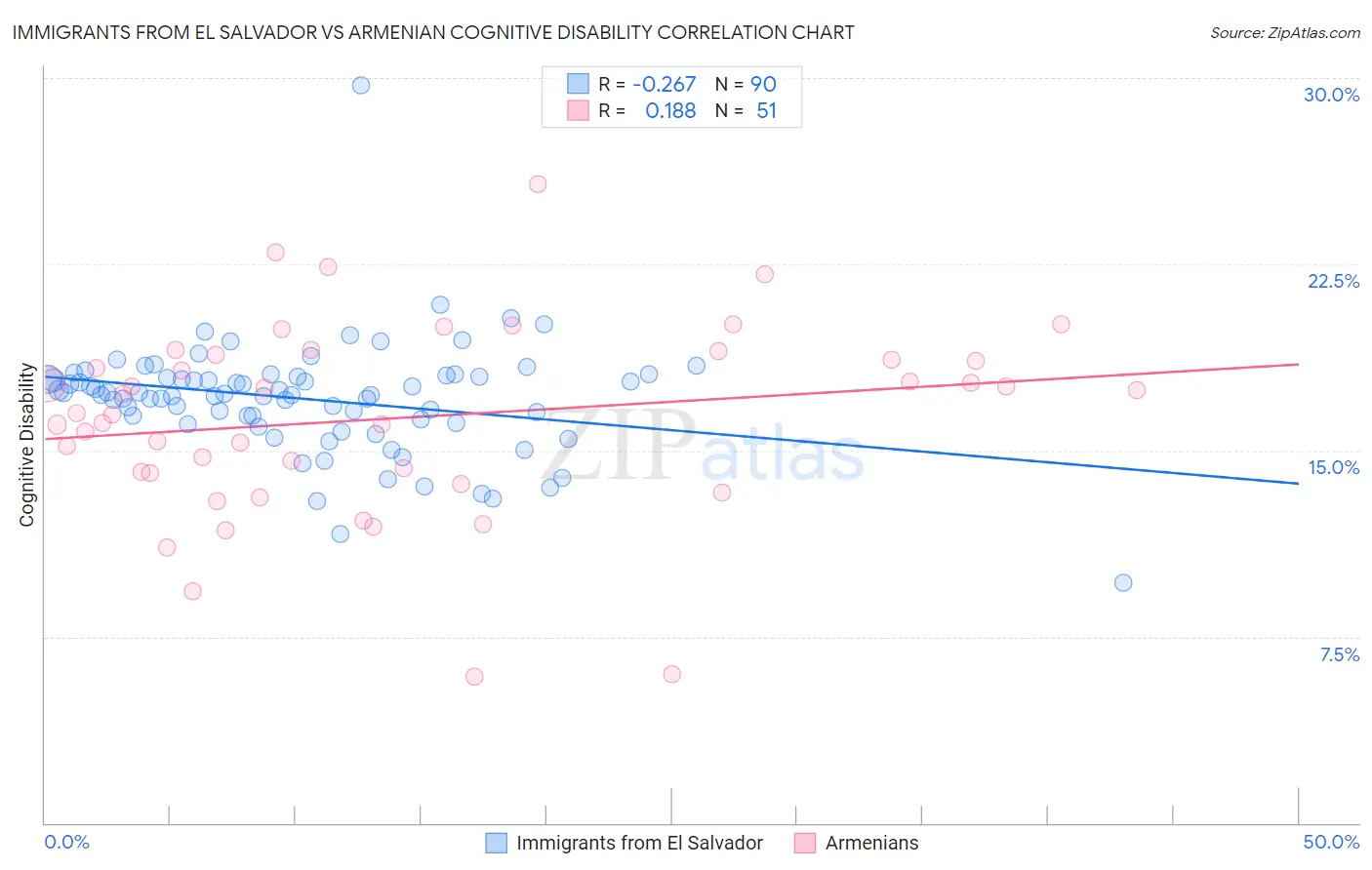Immigrants from El Salvador vs Armenian Cognitive Disability
COMPARE
Immigrants from El Salvador
Armenian
Cognitive Disability
Cognitive Disability Comparison
Immigrants from El Salvador
Armenians
17.6%
COGNITIVE DISABILITY
7.0/ 100
METRIC RATING
214th/ 347
METRIC RANK
17.2%
COGNITIVE DISABILITY
70.1/ 100
METRIC RATING
164th/ 347
METRIC RANK
Immigrants from El Salvador vs Armenian Cognitive Disability Correlation Chart
The statistical analysis conducted on geographies consisting of 357,776,570 people shows a weak negative correlation between the proportion of Immigrants from El Salvador and percentage of population with cognitive disability in the United States with a correlation coefficient (R) of -0.267 and weighted average of 17.6%. Similarly, the statistical analysis conducted on geographies consisting of 310,934,651 people shows a poor positive correlation between the proportion of Armenians and percentage of population with cognitive disability in the United States with a correlation coefficient (R) of 0.188 and weighted average of 17.2%, a difference of 2.5%.

Cognitive Disability Correlation Summary
| Measurement | Immigrants from El Salvador | Armenian |
| Minimum | 9.6% | 5.9% |
| Maximum | 29.7% | 25.7% |
| Range | 20.0% | 19.9% |
| Mean | 17.1% | 16.3% |
| Median | 17.3% | 16.5% |
| Interquartile 25% (IQ1) | 16.2% | 14.1% |
| Interquartile 75% (IQ3) | 18.0% | 18.8% |
| Interquartile Range (IQR) | 1.7% | 4.8% |
| Standard Deviation (Sample) | 2.3% | 3.9% |
| Standard Deviation (Population) | 2.3% | 3.9% |
Similar Demographics by Cognitive Disability
Demographics Similar to Immigrants from El Salvador by Cognitive Disability
In terms of cognitive disability, the demographic groups most similar to Immigrants from El Salvador are Alaskan Athabascan (17.6%, a difference of 0.010%), Hawaiian (17.6%, a difference of 0.020%), Okinawan (17.6%, a difference of 0.020%), Salvadoran (17.6%, a difference of 0.030%), and Immigrants from Oceania (17.6%, a difference of 0.040%).
| Demographics | Rating | Rank | Cognitive Disability |
| Immigrants | Latin America | 9.7 /100 | #207 | Tragic 17.6% |
| Immigrants | Cameroon | 9.3 /100 | #208 | Tragic 17.6% |
| Immigrants | Trinidad and Tobago | 8.7 /100 | #209 | Tragic 17.6% |
| Immigrants | Jamaica | 8.5 /100 | #210 | Tragic 17.6% |
| Taiwanese | 7.7 /100 | #211 | Tragic 17.6% |
| Immigrants | Oceania | 7.3 /100 | #212 | Tragic 17.6% |
| Hawaiians | 7.2 /100 | #213 | Tragic 17.6% |
| Immigrants | El Salvador | 7.0 /100 | #214 | Tragic 17.6% |
| Alaskan Athabascans | 6.9 /100 | #215 | Tragic 17.6% |
| Okinawans | 6.8 /100 | #216 | Tragic 17.6% |
| Salvadorans | 6.7 /100 | #217 | Tragic 17.6% |
| Icelanders | 6.4 /100 | #218 | Tragic 17.6% |
| Immigrants | Sierra Leone | 6.3 /100 | #219 | Tragic 17.6% |
| Zimbabweans | 6.1 /100 | #220 | Tragic 17.6% |
| Moroccans | 5.9 /100 | #221 | Tragic 17.6% |
Demographics Similar to Armenians by Cognitive Disability
In terms of cognitive disability, the demographic groups most similar to Armenians are Yugoslavian (17.2%, a difference of 0.050%), Immigrants from Switzerland (17.2%, a difference of 0.050%), American (17.2%, a difference of 0.070%), Australian (17.2%, a difference of 0.080%), and Immigrants from Latvia (17.2%, a difference of 0.11%).
| Demographics | Rating | Rank | Cognitive Disability |
| Immigrants | Australia | 76.0 /100 | #157 | Good 17.1% |
| Celtics | 74.1 /100 | #158 | Good 17.1% |
| Immigrants | Latvia | 73.2 /100 | #159 | Good 17.2% |
| Australians | 72.4 /100 | #160 | Good 17.2% |
| Americans | 72.2 /100 | #161 | Good 17.2% |
| Yugoslavians | 71.6 /100 | #162 | Good 17.2% |
| Immigrants | Switzerland | 71.5 /100 | #163 | Good 17.2% |
| Armenians | 70.1 /100 | #164 | Good 17.2% |
| Immigrants | Albania | 64.9 /100 | #165 | Good 17.2% |
| Immigrants | Ecuador | 64.4 /100 | #166 | Good 17.2% |
| Immigrants | Syria | 63.5 /100 | #167 | Good 17.2% |
| Immigrants | Immigrants | 62.5 /100 | #168 | Good 17.2% |
| Immigrants | Portugal | 61.8 /100 | #169 | Good 17.2% |
| Ecuadorians | 59.6 /100 | #170 | Average 17.2% |
| Tlingit-Haida | 59.4 /100 | #171 | Average 17.2% |